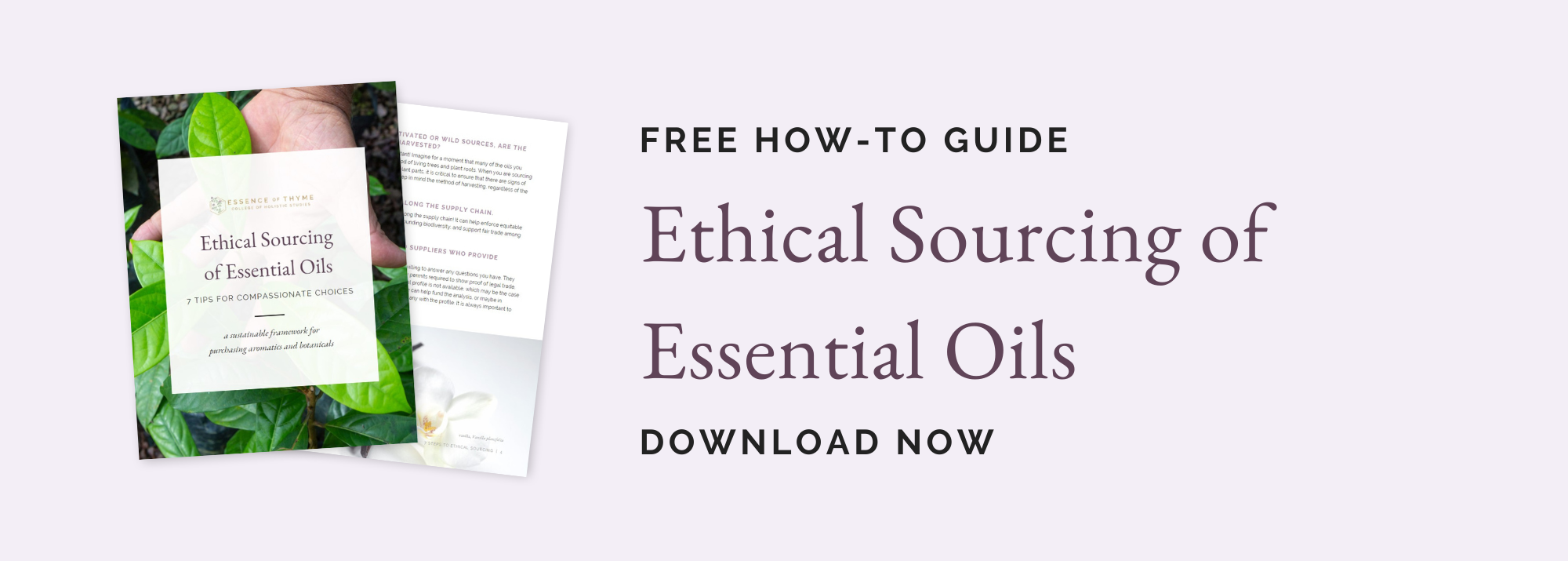Blending Essential Oils in Harmony with the Earth

Blending essential oils and carrier oils with conservation as an intention means working in a way that not only supports the healing of your client, but also the healing of the Earth. While we certainly have a responsibility to our clients, our first responsibility is to the protection and healing of essential and carrier oil-bearing plants. After all, it is upon these plants that the foundation of aromatherapy is built.
The breadth of our work in aromatherapy is extended and enhanced when we don’t limit ourselves to a vision with only a bottle of oil in its scope. Instead, we can hold a wider perspective: a deep understanding that what lies within each bottle of oil is the essence of Nature herself.
To this, healing ourselves and others will only happen if there is harmony with other species and our environment. Without plants, not only plant medicine, but our greatest medicine — the air we breathe — will decline in quantity and quality, leaving very little behind for our future descendants.
Blending in harmony with the Earth must begin now — and it must never cease. We are facing some of humankind’s biggest challenges, such as climate change and an unprecedented loss of biodiversity. We must make decisions every day, and with every drop, that will help us meet those challenges.
There are 3 things to consider when blending in harmony with Nature: a plant’s conservation status, analogs (i.e., substitutes), and plants assessed as Least Concern.
I created this simple conservation-based formula to be used in an eco-friendly inhaler (e.g. recyclable plastic, or a repurposed wood case, and an organic cotton wick) to help support symptoms of agitation and anxiety.
Calm Heart, Green Planet
a calming essential oil inhaler blend
- 3 drops lavender (Lavandula angustifolia)
- 5 drops ho wood (Cinnamomum camphora var. glavescens) linalool CT
- 2 drops Western Australian sandalwood (Santalum spicatum)
- 5 drops sweet orange (Citrus sinensis)
Combine the essential oils in a clean glass bowl and saturate your cotton wick. Remnants can be wiped out with a repurposed piece of fabric and used to scent closed spaces such as drawers, closets, laundry baskets, and travel bags.
How this blend was created
These oils were chosen by firstly considering conservation, followed by therapeutic benefits, and finally fragrance balance.
Here’s how this formula is an example of reasoning and blending from a conservation standpoint:
- Lavender (L. angustifolia) has a conservation status of Least Concern, and is successfully cultivated in many parts of the world. The essential oil is classified as a middle note, and is a mainstay in aromatherapy for its calming support.
- Ho wood (C. camphora var. glavescens) linalool CT essential oil, which is extracted from the leaves, is an excellent alternative to Endangered linalool-rich rosewood essential oil (Aniba rosaeodora), which is extracted from the heartwood. The destruction of mature wild rosewood (A. rosaeodora) trees for the heartwood is one of the main reasons this plant is Endangered. The essential oil is classified as a middle/base note. It blends well with lavender, as they both are rich in a chemical component called linalool; this provides some of the blend’s sedative properties while also harmonizing the aroma.
- Western Australian sandalwood (S. spicatum) and its essential oil are being sustainably managed by Indigenous Peoples in Western Australia. This is a good analog to threatened East Indian sandalwood (S. album) from the standpoint of conservation and overlap in chemical profiles. The essential oil is classified as a base note, and is favoured for its soothing effects on the nervous system, fostering a sense of serenity.
- Although sweet orange (C. sinensis) has not been assessed by the IUCN, it is well established that this tree is abundant, well established in cultivated populations and oftentimes the oil is a byproduct of the citrus juice industry. That being said, ethical sourcing should be applied to all oils and supplies used in aromatherapy. The essential oil is classified as a top note, balancing the aroma of the blend while its gently uplifting nature calms an agitated mind.
I hope this helps us unite in a way that will help to heal the plants, planet, and each other.
If you tried this formula and would like to share how it supported you, or if you also blend with conservation in mind, please let us know in the comments!

Article by: Kelly Ablard, PhD, RA, MIFPA
Kelly has been a certified aromatherapy educator and conservation biologist for over 15 years. She is dedicated to the global education, research, and conservation of medicinal and aromatic plants. Kelly actively works to help protect and promote the uses of traditional medicine in Indigenous communities.

Stay up to date with Essence of Thyme and get new content delivered to your inbox.
About Essence of Thyme College of Holistic Studies
Essence of Thyme College of Holistic Studies offers 300- and 630-hour professional aromatherapy certification programs that help you grow a successful, fulfilling career by specializing and creating your market niche. Professional Level Certification prepares graduates to become aromatherapy consultants, launch product lines or retail businesses, or provide services as an adjunct to existing holistic health specializations. Master Level Certification and electives are ideal for certified aromatherapists seeking higher education or a path to clinical aromatherapy practice.
All Essence of Thyme programs focus on aromatherapy product development and advanced formulation, evidence-based research, spa and business management, international industry regulatory guidelines, and sustainability and conservation of essential oil and carrier oil-bearing plants.
Our comprehensive, evidence-based programs meet or exceed the criteria set forth by 5 international professional aromatherapy associations. Learn more about our aromatherapy certification programs.


